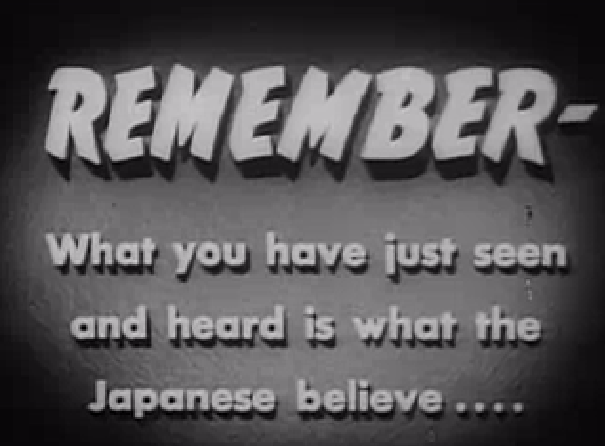
My Japan takes an interesting tact with how it tried to spur Americans to buy war bonds. The film claims to be a captured Japanese propaganda film aimed at demoralizing Americans. The film was, in fact, produced by the War Finance Division of the United States Office of War Information in 1945. The film uses a combination of travelogue footage which came from before the war mixed with actual war footage, including executions, beheaded soldiers, wounded American soldiers, and footage from Pearl Harbor.
The film opens with a white guy squinting and speaking in “Engrish” as he posed as a Japanese man. He speaks about countering misconceived ideas of Japanese people while exemplifying the same stereotypes he claims to speak against. The film uses reverse psychology throughout its runtime to rile the American audience to action. The film frequently shows footage of beautiful Japan, following the usual ideas of “Exotic Asia” which dated all the way to the turn of the 1900s. These scenes include women wearing kimono, farmers working rice fields, cherry blossoms, and similar Japonisme scenes. These are juxtaposed against scenes from the war. Including a scene of Japanese troops removing an American flag and putting up the Rising Sun.
Throughout the film, the narrator in his faux Japanese accent dares the American audience and tries to get their hackles up with statements like “We think you are stupid, an admirable trait in an enemy” and othering statements like “We are not like you.” The film also speaks to the idea at the time that the Japanese didn’t value life with other lines like “You are not willing to pay the price for victory in pain, in work, and in lives” and the idea that the Japanese spend lives lavishly. Of course these statements are punctuated with footage of the dead.
The amount of footage of death, decapitations, mutilations, and other violence surprised me for a propaganda film of this era. The narrator also spoke of how the bombing of Japanese cities wouldn’t end the war. He also spoke of how the gains of the Americans in the Pacific came at the cost of many American lives yet they faced Japan’s expendable troops. Of course, we know the situation was quite the opposite from our vantage point.
The film piled on the insults even further with the idea that Americans only dream of victory rather than work for it and talk of war rather than fight a war. It makes me wonder just how many people in 1945 believed this film was truly a captured film.
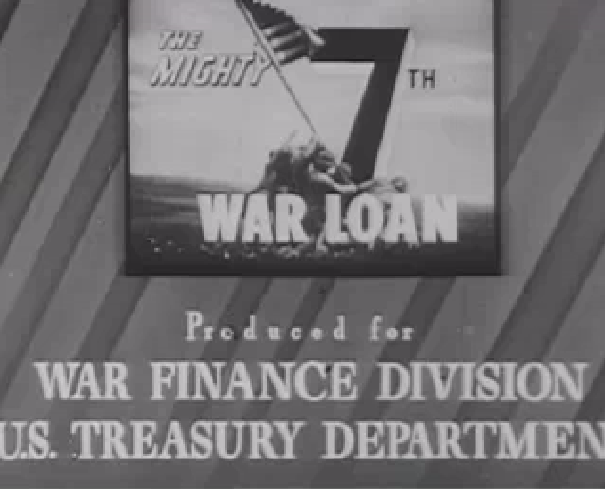
My Japan uses interesting tactics: horror, anger, insult, and challenge. The film uses scenes of death against “beautiful Japan” to whiplash the audience in order to make them more pliable. Next, the narrator in his bad-accent Engrish basically tells the American audience that they aren’t up to the task of winning, pointing out how Japanese people work harder than Americans at lower wages every day of every week (working to win the war) and, of course, buy Japanese war bonds (to win the war). All the insults seek to stir the audience to get angry and take action: buy the war bonds that were no doubt offered by a nearby seller.
In his book, Propaganda (1928), Edward Bernays lamented how literacy didn’t protect people from manipulation efforts like My Japan. In fact, universal literacy exposed people more to such manipulation efforts:
Universal literacy was supposed to educate the common man to control his environment. Once he could read and write he would have a mind fit to rule. So ran the democratic doctrine. But instead of a mind, universal literacy has given him rubber stamps, rubber stamps inked with advertising slogans, with editorials, with published scientific data, with the trivialities of the tabloids and the platitudes of history, but quite innocent of original thought. Each man’s rubber stamps are the duplicates of millions of others, so that when those millions are exposed to the same stimuli, all receive identical imprints.
Of course, he wasn’t against people learning to read. With the rise of film, reading wasn’t even the most effective avenue. He also didn’t view propaganda as a negative word as I (and no doubt you) consider it to be. For him, “The mechanism by which ideas are disseminated on a large scale is propaganda, in the broad sense of an organized effort to spread a particular belief or doctrine.” It was neutral. However, films like My Japan and all the avenues we see today on the Internet supports his idea that we become rubber stamp thinkers manipulated by other rubber stamp thinkers until “We are governed, our minds are molded, our tastes formed, our ideas suggested, largely by men we have never heard of.” If you believe you are an original thinker or an independent thinker, you aren’t. We think with the information we’ve consumed through our culture. While not all ideas are wrong, we still have to beware siloed thinking. The more you agree with an idea, and the more emotional you feel about it, the more you ought to doubt your thinking and response. You might be manipulated or falling into common logic fallacies.
Now, I know I’m getting into tin-foil at territory with the idea of a few people controlling the thinking of the masses. Consider the ploys My Japan uses in the modern context. US presidential races use anger and insults to make people more malleable to certain ways of thinking. Commercials issue challenges not unlike the film: if you buy this product you too can be better, and if you don’t, well, they (the rich, the enemy, the other) beat you. While My Japan’s tactics are on the nose, the tactics the film uses remain with us today. Consider how social media trends influence people. Within recent years all we’ve seen in my part of the US are tattoos and big beards. There’s nothing wrong with either of them. However, they also weren’t common until their fads took hold. People began to follow the trend rather than think for themselves. In this way, a few people who started the fad controlled the thinking of the masses.
In many ways My Japan feels quaint with its overt tactics. Modern methods are more subtle and pernicious with how they manipulate a person’s sense of self using less overt ways. They leverage a sense of belonging or lack of belonging. My Japan told Americans they were were lazy, soft, weak in order to rile anger and make the viewers more likely to impulse purchase bonds. Although I’m uncertain just how effective this film would’ve been. Our modern propaganda sets citizens against each other by using terms like “woke” or “right-wing” in regular language. The idea is to paint people as an “other” and so dehumanize them. Once a person is dehumanized, it is easier to dislike them and, at the extreme, kill them.
My Japan may be an obscure, racist film from 1945. However, the methods it uses to manipulate thought remain in use today. Anger clouds judgment, and tribalistic othering of people remains a powerful and dangerous tool. Only by being mindful of your mind and biases can you notice when these ploys are being used on you. If you feel angry when hearing a word, beware. If you feel a sense of belonging with a certain political tribe, beware. You are open to manipulation. On a lesser scale, if you follow fashion fads like big beards, tattoos, bell-bottoms, or whatever else, you may not be thinking for yourself and instead trying to fit into a particular tribe. Belonging isn’t the problem, but you have to be careful not to have such social ties and group thinking shift who you are and your values. And remember too, as My Japan illustrates, those values can be used to manipulate you too.
Here is the film:
References
Bernays, Edward (1928) Propaganda.
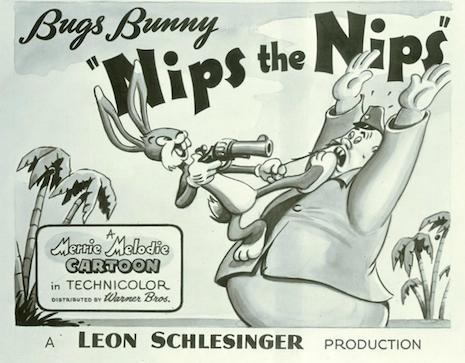
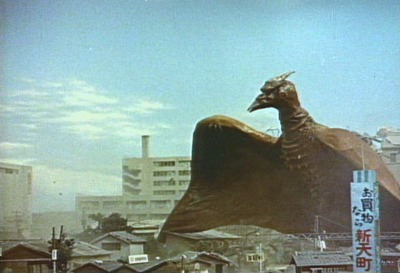
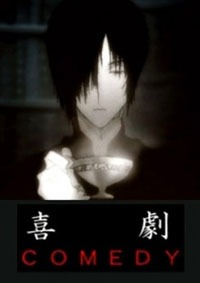
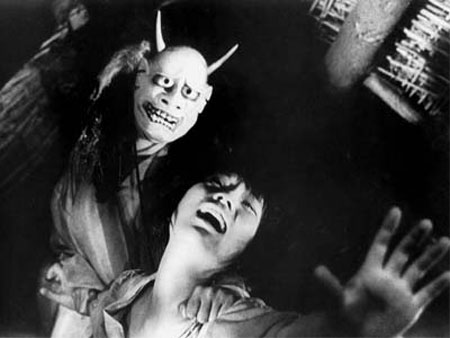
This is quite interesting. Propaganda often appears ridiculous when seen objectively. But the film’s message makes sense when viewed in context. The words at 11:40 are why this film was made.
As the end approached, some Japanese military leaders wanted to fight on to the very last, leading a civilian army wielding farm implements if necessary. Starting in June of 1945, this was reflected in a Japanese propaganda campaign ominously called, “The Glorious Death of One Hundred Million“. Against this, the Allies saw waning interest among a war-wearied populace in continuing the fight in the Pacific, while military leaders calculated staggering casualties for just the occupation of Kyushu. The unusually gruesome images for a film likely shown to a theater audience makes sense in that context. Propaganda has a tendency to escalate.
You touch on why I write so much about history. We need context to understand the messages and media of different periods, and with that contextual understanding, we can learn more about our own period. We’ve seen a similar, if different in direction, escalation of messaging in the US. We will look back on this period and wonder how people could’ve fallen for such “on the nose” and “obvious” ploys.